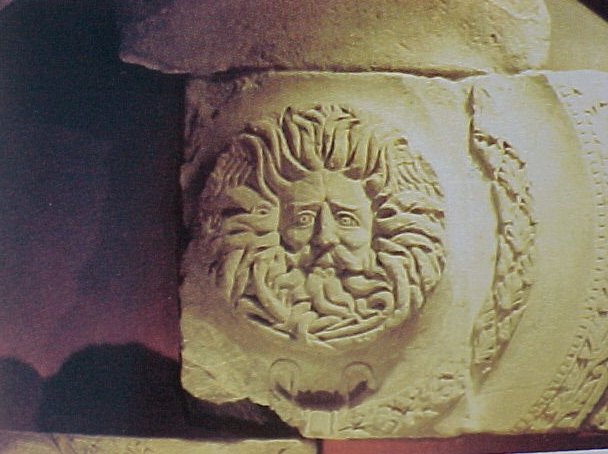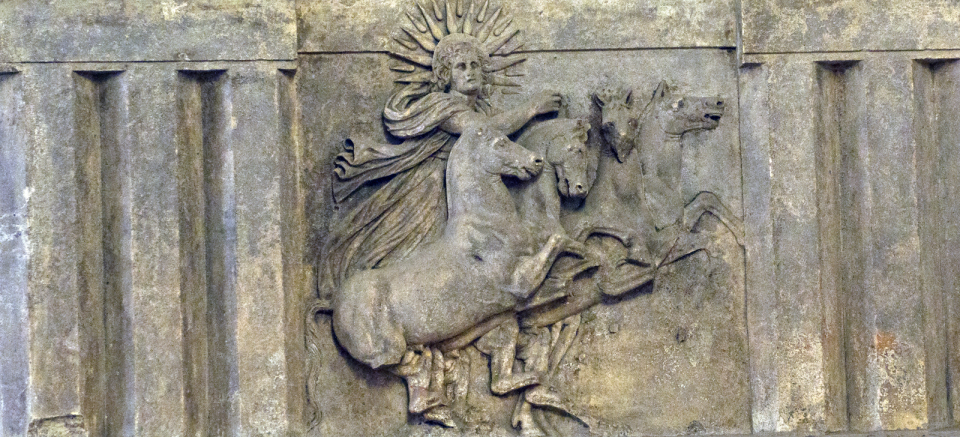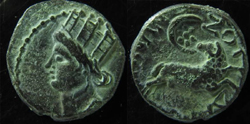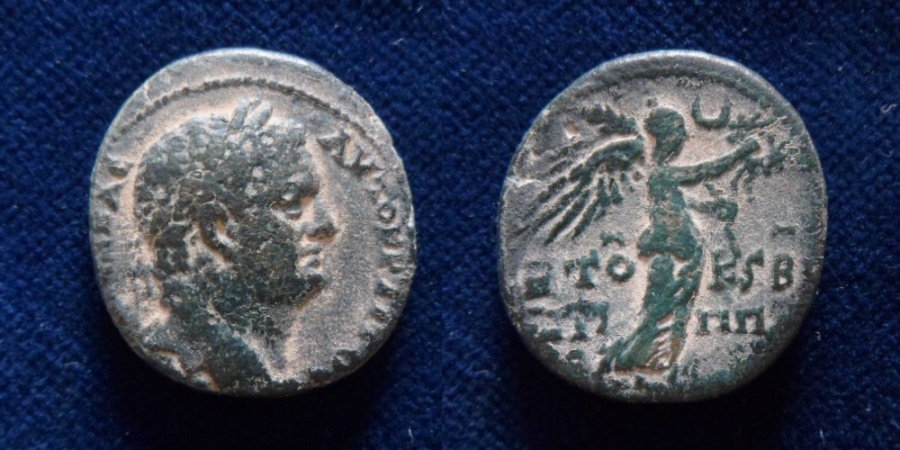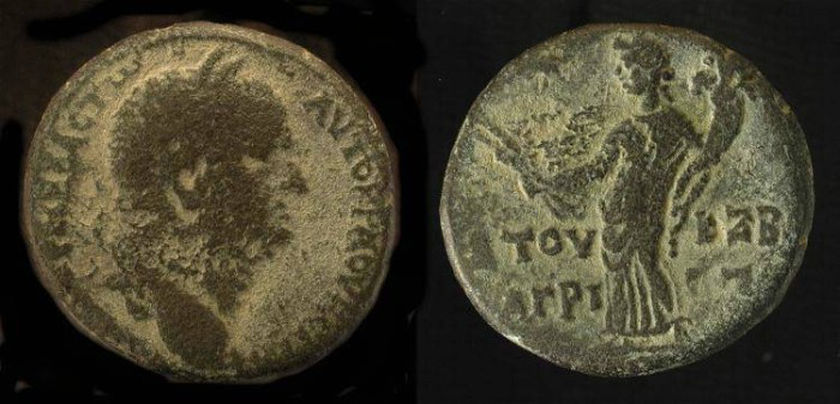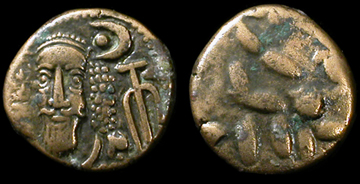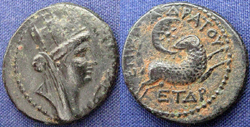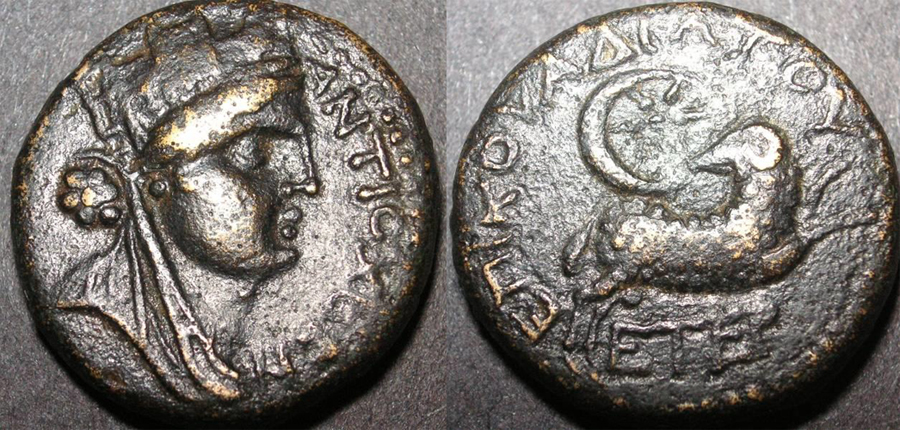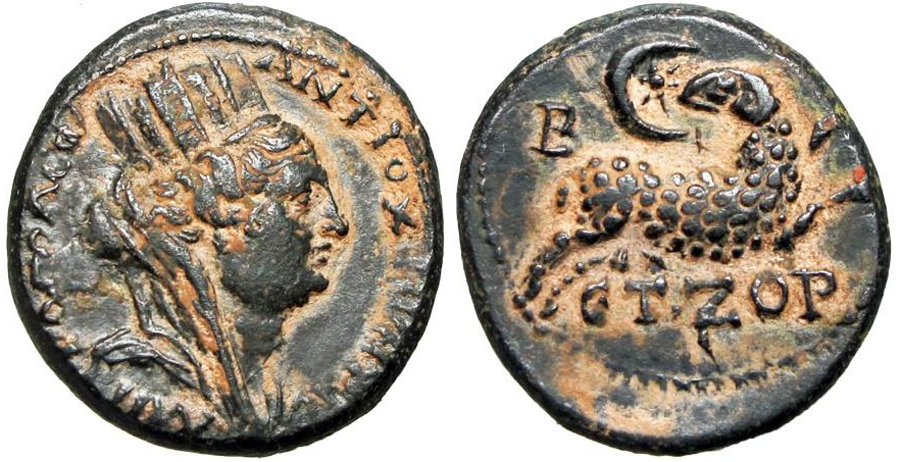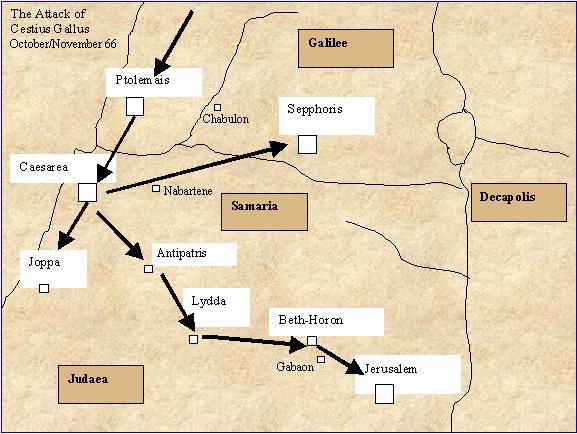Text
12 So the fourth angel trumpeted, and a third of the sun was struck, and a third of the moon, and a third of the stars so that a third of them was darkened; so a third of the day did not shine, and the night likewise. 13 And I saw and heard an eagle flying in mid-heaven saying with a loud voice, three times; “Woe, woe, woe to the inhabitants of the earth because of the remaining trumpet blasts of the three angels who are about to trumpet!”1
Introduction
There has been a logical grouping of the first four trumpets because they all relate to the Roman Legate, Cestius, who is sometimes called Gallus, or Gaius Cestius Gallus. But starting next week we will see that the last three trumpets relate to Titus and his father Vespasian and cover the remainder of the war (at least up to AD 70). And the last three trumpets are called the three woes.
Now, so far we have been seeing that there is a seamless historical progression from chapter 5 up to the third trumpet. We would expect that to continue. I don't buy into the cheating that some people have engaged in when they say that some of the trumpets are out of order. And we have also seen that each of these passages was historically fulfilled to a "t." There is no need to take them out of order. It is remarkable to see the detail with which those prophesies were fulfilled in history. Now, we will not see as much external evidence for the appearance of these signs on this particular trumpet. But before we dig into the passage, let me give you a review of where we have been so far. It has been a long time since I have given you a bird's eye view.
Chapters 4-5 show Christ ascended to His throne in AD 30. And He immediately goes to work in bringing covenant lawsuits against nations. This gives us a paradigm of how he works in New Covenant history. You can't say that it was only nations in the Old Testament that were responsible to God's law. Nor can you say that it was only Israel. Christ specifically applies the standard of the Old Testament canon to unbelieving nations in New Testament times and judges those nations for breaking that standard. I don't know how you could get a better proof for theonomy than that scroll.
I have been arguing with people on the web about politics, and I am astonished at how frequently Christians claim that the New Testament doesn't speak to politics, that Jesus isn't interested in establishing Christian nations, that God's law does not apply, and that our guiding principle should be pragmatism, not the Bible. But chapters 4-5 show Christ as not just the Savior of the world but also the Lord over the whole world. And we saw that He was judging the nations by God's Old Testament law. So it is a marvelous passage on Law and Gospel. And He is determined to spread His Gospel to the ends of the earth. And we have been seeing that nations that embrace the Gospel will be blessed while nations that reject it will be cursed. What is useful about these chapters is that they form a paradigm for the rest of history - how Jesus judged Rome and Israel is a paradigm for how Christ will continue to deal with all nations in our own time. This book assures us that we can expect continued judgment in America if America does not repent.
Now I say "continued judgment" because we have been under judgment for a long time. We saw that the first few seals in chapter 6 demonstrated that fact. Statism is one of Christ's judgments. If citizens worship the state as god, the true God will make them suffer under their messianic state; He will make them groan under their idolatry.
So in chapter 6:1-2 we saw that the first seal related to Christ inflicting the Roman emperor Tiberius upon the world as a judgment. Then comes Caligula in verses 3-4. That's the second seal. That's even worse. Then comes Claudius in verses 5-6. That constituted a massive increase in the centralization of government. That's a judgment. But they still looked to the state as savior, so Christ inflicts the world with Nero in verses 7 and following.
So in terms of structure you will notice that the first four seals are brief and introductory and the last three seals go into great detail, just like the first four trumpets were brief and introductory and the last three trumpets go into great detail.
The fourth seal deals with the first part of Nero's reign in AD 54-61. The fifth seal deals with AD 62 to early 66. The sixth seal is in early May of AD 66. Then there is a discussion of all the martyrs as well as those whom God chose to seal and spare. Then in chapter 8 we get to the seventh seal, which takes place on May 18, or Sivan 6. That seventh seal seamlessly moves into the seven trumpets.
The first trumpet in verse 7 is on September 8, the first day of the feast of trumpets. The second trumpet comes immediately after that in early September. The third trumpet is later in September. Then, 30 days after he began his war, Cestius camped at Jerusalem. But on October 15 he suffered a stunning defeat at the hands of the Jewish rebels.
So the signs in the fourth trumpet take place sometime in the first two weeks of October and they foreshadow the imminent fall of Cestius, Herod Agrippa, and a third of the pro-Roman Sadducean priests.
Are there historical hints that this literally happened?
Now, I mentioned that the specific signs in this fourth trumpet are not nearly as well documented in secular history as the earlier ones were. What was symbolized is very well documented, but we have hints that even these miraculous signs were indeed fulfilled. It's rather thin evidence, but let me give you the three historical hints that I have found so far.
First, the early historian, Hegesippus, says that right at this time there were "signs in the sun and the moon and the stars." He doesn't say what the signs were, but there was something weird going on at this time with all three. And I think it is significant that all three are mentioned. So I would say that Hegesippus is the first proof that this passage was indeed fulfilled. It's just a hint, because there are no details, but he says that something astounding and noteworthy took place in the sun, moon, and stars.
Second, Josephus also speaks of multiple signs in the heavens in AD 66. By the way, the Greek word Josephus uses for a sign is a synonym for a miracle or something unexplainable. He doesn't specify what all of those signs were or when they occurred. He implies that they occurred in AD 66. Hegesippus makes that quite specific. But Josephus may well be referring to the same signs.
The third hint is actually used by some to place this trumpet in AD 68 (where it doesn't belong). And since exegesis trumps secular historical records every time, we are going to stay anchored in October of AD 66. But I am going to quote Dion Cassius because the signs that he mentions may well have taken place earlier - right at this period of time. And I will explain why in a bit, but let me quote him first. Cassius says,
A comet was seen, and the moon, contrary to precedent, appeared to suffer two eclipses, [and note this phrase:] being obscured on the fourth and on the seventh day. Also people saw two suns at once, one in the west weak and pale, and one in the east brilliant and powerful. (Book LXIV, chapter 8)
The reason some people date these signs to AD 68 is because Cassius thought that these signs were previous omens that Vespasian would replace previous emperors. But he says that these signs took place before Vespasian's soldiers urged him to be emperor in the Fall of AD 68. Cassius doesn't say how much before that that the signs occurred; simply that they occurred earlier. Many people assume that they occurred in 68, but it doesn't say that.
Secondly, I have scientific data that seems to indicate that at least his first sign had to have occurred two years earlier. If you go to NASA's website and trace out the appearance of all the comets that we know about, there were none that appeared in AD 68, but there was one that appeared around January 25 of AD 66. That was Halley's comet. And other historians referred to that same comet as the first of several signs throughout the year of AD 66. So, if (as Cassius seems to indicate) the other signs followed the comet (just like other historians have said), and if the comet that he refers to was Halley's comet, then Cassius' signs are probably exactly the same signs that Hegesippus refers to, and that means they all took place at this period of time.
So that's the extent of the historical record as far as I have been able to discover. It is all slim evidence, but at least it is there. That means that there has not been a single passage in the first eight chapters that has not been said by some historian to be fulfilled literally as well as symbolically.
Possible explanations of this literal darkening of sun, moon, and stars
And I won't spend a great deal of time describing how these signs could be scientifically possible. People have tried to explain Cassius' signs in terms of optical illusion in the atmosphere - perhaps because of smoke or the ash from volcanism. Others have discounted the signs. I don't feel like I need to defend Cestius.
But there are skeptics who like to scoff at anything in the Bible, and they scoff at the idea of a third of the sun could ever be struck - in the future or in the past. They think that is ridiculous. The claim is that life on planet earth would cease to exist if a third of the sun's light was struck. So let me at least give enough information to be able to answer the skeptics.
My first answer is exegetical. Some people push this to the end of history because that objection bothers them. But Evangelicals should not do that. Verse 13 makes clear that whatever striking this was, there were people living after it. It is not the end of history. There is all of the history of chapter 9-11 that still needs to take place. It says, “Woe, woe, woe to the inhabitants of the earth because of the remaining trumpet blasts of the three angels who are about to trumpet!” The words "remaining" and "about to" indicate historical sequence. You can't mix the trumpets up like so many commentaries do. Whatever the striking of the sun was, it was not designed to wipe out the planet, and to imply that it was so designed means that we have misunderstood what God meant by striking one third of the sun. So that is our inspired guide on how to interpret these signs.
Second, you can respond with the three historical references to the weird things that happened in AD 66 to the sun, moon, and stars. And Hegesippus clearly ties those things to precisely this period of time.
But thirdly, there are some quite plausible scientific explanations of what could have happened at that time. I am not saying that any of them are true. I am simply saying that if any one of these is a credible possible explanation, then skeptics can't claim that the passage is scientifically wrong.
Theory 1 - Volcanic dust from earlier trumpets obscures light by one third
The first explanation is perhaps the simplest one. We have already looked at the volcanism of the Mediterranean region around Greece and Italy that had started to occur in May of AD 66 and that continued to erupt all the way into the Fall. There is a great deal of scientific evidence for that.
Well, with the megatons of volcanic ash that would have been thrown into the jet stream of the atmosphere, a lot of that could have blown over the whole Mediterranean region. Couple that with the fact that one ounce of soot apparently absorbs 25,000 times more sunlight than one ounce of dust ordinarily absorbs, it is not at all hard to imagine both daylight and night-light from moon and stars could have been diminished by one third. And interestingly when Joel 2 prophesies this same war it couples the darkening of sun and moon with "pillars of smoke". If you take the pillars of smoke as the smoke from volcanoes, then that reference adds some credibility to this theory.
Theory 2 - The burning villages, forests, and grass (lit by Cestius) were obscuring one third of the light
The second explanation is similar. We know from history that Cestius had lit much of Galilee and Northern Judea on fire. So by the time that he got to Jerusalem to lay siege to it, the smoke from these towns and from the forest and brush fires may have obscured a great deal of the light.
Theory 3 - coronal hole in sun
But some people object that those interpretations are not sufficient. They say that that those interpretations do not constitute the sun being struck; that would simply be the sun being obscured. They say that verse 12 demands that a third of the sun itself be struck. So they suggest that this could be one of those coronal holes that happen from time to time. In your outline I have given three pictures of coronal holes, one dating from June 18 of 2013, which has a different filter.
NASA says of that picture,
NASA's Solar Dynamics Observatory captured this picture of the sun on June 18, 2013, showing a huge coronal hole – seen here in dark blue - spread out over almost the entire upper left quadrant of the sun. A coronal hole is an area of the sun's atmosphere, the corona, where the magnetic field opens up and the material flows quickly out. This results in a cooler and less dense atmosphere than the surrounding areas. This coronal hole is at least 400,000 miles across, which is more than 50 Earths side by side. Coronal holes spew out fast solar wind, probably traveling at about 400-500 miles per second. This is roughly twice the speed of the normal solar wind...2
And it goes on to describe geomagnetic storms that scientists classify as to severity. They go from G1 (which is minor) to G5 (which would completely take out our electric grid and cause many other problems). Could that be what is being referred to as the sun being struck? It could be.
And we know that other suns or stars can have these same dark spots. Recently NASA discovered a dark spot on the sun known as XX Triangulum (or HD 12545). This sunspot was the largest ever found on any sun to date, much larger across than the entire dimension of our own Sun.3 So could a third of the stars literally have been struck with coronal holes covering a third of their of mass? Perhaps. I'm skeptical that would be needed to fulfill the language of our passage, but it could have happened. It's a plausible explanation.
Theory 4 - God's glory cloud which had left the temple in seventh seal obscures the light
The fourth theory that I have read ties this in with God's glory cloud, which we saw in verses 1-6 had left the temple on Pentecost of the same year and stayed on the Mount of Olives. I read one author who said that this glory cloud could have brought supernatural darkness then just like it brought supernatural darkness to the Egyptians at the Red Sea at the time of the Exodus. It could have darkened a third of the day and it could have darkened a third of the night. So that is theory 4.
Another possibility - a combination of any or all of these theories
And then one last possibility would be a combination of any or all of the those four theories, or perhaps something totally different that no one has thought of yet. The first part of verse 12 could refer to sun, moon, and stars themselves being struck, while the last part of verse 12 could refer to the light being obscured. In one sense, it doesn't matter if we know how that happened. Exegesis is not dependent on history. We have been seeing the signs of all the seals and trumpets literally happened in history, and there is no reason to assume that they did not happen exactly as stated here in October of AD 66. That would certainly explain the mention that Dion Cassius and Josephus make of signs or miracles in the sun, moon, and stars. By the way, there are some who say that the coins on the back side may be a fourth hint that sun, moon, and stars were impacted in some way.
What did these things signify/symbolize?
So that is all I am going to say about the literal fulfillment of these signs. The more important question that we need to ask each time is this: "What do these things signify or symbolize?" Keep in mind that all of the literal historical events were called symbols in the book of Revelation - just like the rock smitten by Moses in the wilderness was a literal rock, but also stood as a symbol. So what do these things signify or symbolize?
The sun symbol was a well known symbol for Rome, so a third of the sun being struck symbolizes one third of Cestius' army being destroyed and Cestius fleeing in disgrace. (cf. Gen. 37:9; 2 Sam. 23:4; Is. 13:10; 24:23; Ezek. 32:7)
In Scripture, sun, moon, and stars are symbols of some kind of leadership. Usually the sun refers to either a top leader (as in Genesis 37:9) or to an empire, while the moon is a vassal king or a leader who represents the top leader or who reflects his light.
So in 2 Samuel 23:4 the sun symbolized any king of any nation. But in Isaiah 13:10 and in Isaiah 24:23 the sun symbolized the empire of Babylon. In Ezekiel 32:7 the sun symbolized the empire of Egypt.
And that's the way commentaries normally take the symbol of the sun here. If this occurs in the first century (which I have been forced by exegesis to conclude), we would expect that the sun would be a symbol of Rome as the biggest and baddest power. And it was. You saw it on the coins. You saw it on the temples, on cameos, and in other engravings. I think that would have been the first thing that would have come to the minds of the Christians who first read this letter and who had handled the coins of the empire all their lives. Numerous coins represented Rome as the Sun God, Sol.
Nero had an elaborate dining room constructed that had a dome with the moon and the stars on it and the universe revolving around him once every 24 hours. It was a very sophisticated piece of machinery run by slaves  Right around the time of this trumpet Nero was in Greece "winning" Olympic races and declaring himself to be the Unconquered Sun, Sol Invictus. And he was part of a tradition of emperors being pictured as the unconquered Sun on coins for the next two-and-a-half centuries. Little did he realize that the Scriptures portrayed him as the Conquered Sun.
Right around the time of this trumpet Nero was in Greece "winning" Olympic races and declaring himself to be the Unconquered Sun, Sol Invictus. And he was part of a tradition of emperors being pictured as the unconquered Sun on coins for the next two-and-a-half centuries. Little did he realize that the Scriptures portrayed him as the Conquered Sun.
How did that happen? The Roman Legate, Cestius Gallus, was sent by Nero to punish Israel. Well, his Legions would go down in flames before the Jewish rebels, and one third of his army would be killed. He was so humiliated by this defeat that many people believe that his death was actually a suicide. Josephus seems to imply that. And I will fill you in on the history in a bit. But the coins, temple artwork, cameos of Nero, and other representations frequently use the sun-symbol as the symbol of either Nero or of the empire of Rome as a whole.4
The moon symbol references a subsidiary vassal of Rome, in this case Herod Agrippa. One third being struck refers to one third of his army being destroyed in the battle.
But since the moon's whole purpose is to reflect the sun, the coins of the vassal kings represented them as moons. And there are hundreds of coins that symbolize tributary kings with a moon. And interestingly, it is a crescent moon or a partial moon. Many analysts say that it is a struck moon and a struck sun at the same time.
So the same Biblical passages that I alluded to earlier show the sun as the highest power and show the moon to represent tributary powers. I have put two coins into your outline that show Herod Agrippa. One has the moon on the obverse and the other has the moon next to his head. Why the moon? His sole job (as far as Rome was concerned) was to reflect Rome's rule. He was responsible to keep Roman peace in his region. He couldn't have his own light; he could only reflect Nero's light. So Herod Agrippa II joined Cestius to fight against Israel, and he too lost a third of his soldiers. A third of the moon was struck. First century readers would have gotten all of that immediately. I have to explain it to you simply because we are removed from that history by almost 2000 years.
The stars (plural) refer to the pro-Roman Sadducees losing one third of their members to death or defection
But we saw last week that the Sadducees had claimed the star as a symbol for the high priesthood and of the Sadducean Party, and if a great star represents the most powerful ruler of the Sadducees, we would expect that the other stars would represent the remainder of the Sadducees. And one of the coins commemorating the defeat of Israel shows a woman with the moon and stars being plucked. That coin perfectly pictures this war.
I don't have historical references that describe exactly how many of the Sadducean party were killed or how many vacated the city in October of AD 66. We know that they were virtually wiped out completely by AD 70, but all that Josephus tells us is that Ananus the high priest, numerous leaders with him, and numerous pro-Roman priests were killed after they tried to let Cestius' army into the city. Likewise, after the defeat of Cestius, Josephus tells us that a good chunk of the wealthy sector of the Jews left Israel the moment the Jews chased Cestius through the countryside. It was their one window of time to escape, and it was the very last time that the Christians would have been able to escape without being killed as traitors or defectors. After that, anyone who was in Jerusalem was pretty much a prisoner. The rebels would not let anyone leave. Anyway, Josephus says,
After this calamity had befallen Cestius, many of the most eminent of the Jews swam away from the city, as from a ship when it was going to sink... (War 2:556)
Those eminent Jews may have been some of the stars represented. Others may have been the priests who were killed. But this text is clear. It tells us that Jerusalem lost one third of these high priestly leaders.
The eagle pronouncing woe upon the "land" (i.e., the land of Israel) represents the eagle standard that the Jews captured from Cestius and carried in celebration. They thought it spoke of God's favor. God here explains that it spoke of guaranteed woes (chapters 9ff). It stands as an immediate precursor to the trumpet blasts of the three remaining angels.
The last symbol that is given in these verses is of an eagle flying through the midst of heaven and saying with a loud voice, “Woe, woe, woe to the inhabitants of the earth because of the remaining trumpet blasts of the three angels who are about to trumpet!” And the word earth there should have been translated as "land," not "earth," because the woes are being pronounced against Israel.
While Josephus does mention one time when there was the voice of a person that no one could see yelling loudly, "Woe! Woe! Woe! to Jerusalem!",5 I won't be dogmatic on whether that voice was the same one as this voice. I don't think it would have to be a literal voice in the heaven since literal eagles don't talk. Well, I guess God could have had a literal eagle fly through the air and talk. It would then stand as a symbol for the Roman eagle. But since eagles don't talk, even the most literalist of commentators say that this must be a symbolic eagle symbolically speaking Israel's doom.
Well, was there a symbolic eagle in history? Yes there was. I believe that this was the eagle standard that was captured from Cestius' Legion by the Jews on October 18. It was extremely rare in Roman history for an eagle standard to be captured, and when it was, Rome did all in its power to fight back and regain that eagle. It was a symbol of Rome itself being captured, so Rome could not ignore such a shameful state of affairs.
So while the Jews thought that the capture of the eagle signaled a resounding defeat of Rome like happened under the ancient Maccabees, God declares that this destruction of one third of Rome's army and the capture of Rome's eagle was not something to rejoice over. As they carry it high in the air with great jubilation as a symbol of their victory, it is actually screaming their defeat. It is guaranteeing the next three woes. All hell was literally unleashed upon Israel in the next three trumpets, which cover the rest of the history up to AD 70. The last trumpet is blown at the end of chapter 11.
The history behind these symbols
Now, because it is so easy to forget the flow of history that is being symbolized in this chapter, let me give a bird's eye review of the history of the whole chapter, or at least beginning with verse 7, where the first trumpet sounds. The first trumpet is when Cestius came into Galilee with 30,000 highly seasoned soldiers. The heart of the army was the Twelfth Legion, and it was supplemented by the Fourth and Sixth Legions as well as armies from other allies. If you were living in the first century, you would have been very familiar with everything I am about to tell you.
Cestius started attacking Galilee because that was the thickest hotbed of Zealot rebel activity. That was on September 8, and verse 7 indicates that the whole countryside began to be burned to the ground, with a third of Israel's forests being destroyed. In Galilee, an estimated 100,000 Jews were either killed or sold into slavery. That's just from Galilee. Massive numbers of refugees fled ahead of the army down to Jerusalem, swelling the size of that population. Later in Revelation John will talk about massive numbers of Jews that were killed in Jerusalem, and people wonder how that could be. That's far more then Jerusalem's regular population. But Jerusalem's population was swelled from two things - 1) pilgrims from around the world continued to come to Jerusalem for the festivals and they were le t in but not let out. 2) Second, refugees who fled from Cestius were let in but not let out. It was almost as if God was starting to fill up the city for judgment.
Then if you look at the map you will see that Cestius came into Judea taking Caesarea, Joppa, Antipatris, Lydda, and Beth-Horn and then finally advancing toward Jerusalem with his armies. But as he started approaching the city, the citizens of the city came streaming out to fight. Let me read you Josephus' eyewitness account.
The Jews, seeing that war was now approaching the capital, abandoned their feast and rushed to arms, and with full confidence in their numbers, but without order, leaped boisterously into the fray, disregarding the seventh day's rest, for it was the Sabbath which they usually observed with special reverence. But the passion that shook them out of their piety carried them to victory in the battle; and they fell upon the Romans with such fury that they broke and penetrated their ranks, killing many. Had not the cavalry, with part of the infantry which was not so hard pressed, wheeled around to the relief of the broken line, Cestius with his whole army would have been in jeopardy. Five hundred and fifty Romans were killed - four hundred infantry and the rest cavalry; the Jews lost only twenty-two...
Their frontal attack halted, the Jews retreated to the city, but from the back of their lines, Simon, son of Gioras, fell upon the Romans from the rear as they were mounting towards Beth-Horn, cut up a large part of their rear guard, and carried off numbers of their mules which he then drove into the city. While Cestius remained in his former quarters, the Jews occupied the heights and kept guard on the columns, clearly not intending to remain inactive if the Romans began to march.
At this point, Agrippa, realizing that not even a Roman army was safe when such a huge force occupied the surrounding mountains, decided to try to confer with the Jews; he hoped either to prevail on all to cease hostilities, or at least detach from their opponents those who did not share the views of the war party. Accordingly, he sent his two friends, both known to the Jews, Borcius and Phoebus, with an offer of a treaty on the part of Cestius, and of a sure pardon by the Romans for their offenses if they laid down their arms and returned to their allegiance. But the insurgents' fear that the prospect of an amnesty would induce the entire army to go over to Agrippa, violently assaulted his emissaries. Phoebus was murdered before he had uttered a word, Borcius was wounded but managed to escape. Citzens who protested this outrage were attacked with stones and clubs and driven into the city.
Cestius, seeing that these internal dissensions in Jerusalem presented an opportunity for attack, brought up his entire army, routed the Jews, and pursued them to Jerusalem. He pitched his camp on the so-called Mt. Scopus, seven furlongs from the city, and suspended all attack upon it, perhaps expecting that the defenders would surrender, but he sent out many foraging parties to the surrounding villages to collect grain. On the fourth day, the thirtieth of the month of Hperberetaeus, he deployed his forces and led them into the city. For the people were under the thumb of the insurgents, and the latter, overawed by the orderly discipline of the Romans, abandoned the suburbs and retreated into the inner city and the Temple Mount. Cestius, on arrival set fire to the district known as Bezetha or "New City" and the so-called Timber Market; he then proceeded to the Upper city and encamped opposite the royal palace. If he had chosen at that very hour to force his way through the walls he would have captured the City immediately, and the war would have been brought to an end. But then his camp prefect Tyrannius Priscus and most of the cavalry officers, bribed by Florus, dissuaded him from the attempt. Thus it came about that the war lasted so long and the Jews drained the cup of irretrievable disaster. (War 2:513-527)6
The pro-Roman moderates who were inside the city (mainly Sadduccees) sent invitations to Cestius, promising to open the gates to him. They begged him to come in and put and end to the unrest. But Cestius, again for some reason unknown to us, failed to take advantage of that opportunity. It would have made everything so easy. When the rebels discovered what the moderates had offered, they were outraged, arrested them, and later had them killed. In the meantime, Cestius waged an incredibly successful assault, took over the city, after five days managed to undermine the wall, and was on the verge of setting fire to the gate of the Temple Mount, when he mysteriously stopped. Once again, it would have been just a matter of hours before he would have conquered the city completely. It would have been so much easier on Israel if he had done so. But he didn't follow up on his advantage. You can see that there were higher powers dictating that the judgment continue.
Nobody knows why, but Cestius gave up the assault and retreated. He had almost won the war, but he retreated. It doesn't make any rational sense. When the Roman army retreated, the rebels gained heart (thinking God was on their side) left the city and attacked Cestius' army. Cestius was hemmed in on all sides, and in desperation, he left behind four hundred of his best men as a ruse, to make the Jews think that he was hunkering down to fight. But in reality, he had left the four hundred of his best men behind to be massacred, while the rest of the army barely escaped complete annihilation. In that battle alone he lost 6000 men. And most damaging to the Roman pride was the loss of their golden eagle. In their haste to flee, they also left behind massive amounts of baggage, food, and weapons of war, which the Jews captured and used for their later defenses. Josephus gives a lengthy description of this slaughter of the Romans. One third of Cestius' army was lost, one third of the auxiliary armies were lost, and one third of the pro-Roman forces in Jerusalem were lost. It was a massive judgment upon both Israel and Rome. And I don't know how you could have more eloquently symbolized what happened than John did with the language in these two verses.
Of course, the rebels didn't recognize it as a disaster. They took this miraculous victory as a sign that God was on their side and that this would be the beginning of Israel's liberation, and that they would start a new republic of Israel, just as the victory of Judas Maccabeus against Antiochus Epiphanes had led to the miraculous restoration of Israel three hundred years earlier. Of course, all of the leaders of the factions were vying to be the new leader who would be thought of as the Judas Maccabbeas. So the next three years would involve Jerusalem in a desperate struggle for power between the Jewish factions.
Josephus mentions that it was during this brief period alone (beginning October 18 and lasting for only a couple of days) that anyone was able to escape the city. And he mentions many who did leave. This may have been when the last of the Christians left as well. Jesus had warned them in Luke 21,
Luke 21:20 ¶ “But when you see Jerusalem surrounded by armies, then know that its desolation is near. Luke 21:21 Then let those who are in Judea flee to the mountains, let those who are in the midst of her depart, and let not those who are in the country enter her. Luke 21:22 For these are the days of vengeance, that all things which are written may be fulfilled. Luke 21:23 But woe to those who are pregnant and to those who are nursing babies in those days! For there will be great distress in the land and wrath upon this people. Luke 21:24 And they will fall by the edge of the sword, and be led away captive into all nations. And Jerusalem will be trampled by Gentiles until the times of the Gentiles are fulfilled.
Conclusion
Jesus is in control of armies, not Satan (v. 12a with verse 1)
We have already looked at a couple of applications, but let me end with two more. The first phrase in verse 12 indicates that the first cause of this war was not men or even Satan. Verse 12 says, "So the fourth angel trumpeted." It was an angel who trumpets for his legions to engage that began this conflict. And who gave these angels permission to sound their horns? Verse 1 indicates that Jesus did. He opened the seventh seal, indicating that He initiated this sequence. He is the sovereign over history.
Now that is not to say that Satan is not at work too. He is. The next three chapters show the irrational rage and hatred that Satan and his demons have for God's creation. But little did Satan realize at that time what a pawn he was in Christ's hands. It was Christ's angel that started the chain reaction of events leading to Cestius' killing and enslaving 100,000 Jews in Galilee alone, and who knows how many in Judea. It was Christ's angel who begins a chain reaction of events that guaranteed that the Jewish rebels would reduce Rome's huge army by one third. These were His covenant lawsuits against both Israel and Rome.
The point is, that it is easy to lose sight of God's sovereignty when things get bad. But we must rest assured that Jesus has the power to use the enemy as pawns on His chess board. Both the rebels and Cestius were unwitting agents of judgment upon each other. God can use Obama, Hillary, Trump, or anyone else that He chooses as instruments of judgment. Never forget that God is sovereign and that Jesus is on His throne.
We should not think that "conservative victories" mean that God is pleased with the nation. Until sin is repented of, we are in trouble
The second thing that I learn is that so-called "conservative victories" that we achieve in politics are not the solution to this nation's rebellion. Would our nation be out of danger of Christ's anger if Trump happens to win and if he happens to keep his promise to put in good judges? No. There is so much more that Christ is angry over. Nothing short of repentance will stem that anger. Can such things slow down the pain a bit? Yes. Can they be useful? Yes. But never forget that this is Christ's world, and victory must be defined on His terms. If Jesus is not pleased with the political victory, it is not a victory at all. We must look at religion and politics through Biblical eyes.
I bring that up because some people in Israel would have considered the invitation of Ananus the high priest (War 2:533) to open the doors of the city to Cestius to be the wise thing that would have stemmed disaster. But even if they could have done it, would Christ's anger have been removed? No. Josephus certainly thinks that this attempt at appeasement by the pro-Roman faction would have saved the country. Josephus was wrong. It would not have saved the country. It would have been a temporary political victory. Certainly they could have negotiated the removal of the horrible Roman procurator, Florus, and gotten a decent position for themselves. But it would not have removed Christ's anger.
Others might have considered the capture of the eagle and the routing of the Romans to be a conservative victory. There were plenty who were excited. That victory led many people to come to Jerusalem to join in on the fun. They wanted to get in on this rebellion. But did that victory remove Christ's anger? No.
And actually, there were at least four perspectives among the factions of this time on what would constitute a victory. None of them were right. True victory must be defined as repentance and bowing before King Jesus as Lord of the nation, Lord of the church, and Lord of the family. Jesus doesn't negotiate political deals like the Democrats and Republicans do. He makes demands of unconditional surrender. Until that happens, our nation is in deep trouble.
But can it happen? Yes. It happened under the First Great Awakening. The politics, crime, and character of our nation was pathetic before the First Great Awakening, but God's Spirit swept through the land and the cultural changes were amazing. Will God do it again? I have no idea. I am encouraged that God is raising up so many ministers and ministries that are calling our nation back to Jesus and His Bible. But ultimately it is not up to us to know if this will be a success. Ours is the duty; the results are God's. Let's just make sure that we label victory and defeat properly. It is my conviction that no matter which candidate wins the presidency; no matter which party takes over the Senate, God is pronouncing woes upon our nation. Things will continue to get worse and worse until there is true repentance. And it is high time that the church calls people to repentance, back to the old paths, back to the Law and the Gospel.
Israel never did repent, and it was left a desolate house; dry and demonic. I am convinced by other prophecies that there is coming a day when that nation will repent and become Christian because all nations eventually will. But they stand as a testimony to me of what happens to a nation that looks to politics as its savior. It will be left as a dry and desolate house. And as chapter 9 shows, it will be left as a haunt of demons. I don't want that for America, and that is why I do not see politics as savior, even though Christians must be involved in politics. It is so important that Christians not put their hope in princes of any stripe. Christ's anger can be removed by one thing alone - repentance, which will lead to being washed in His blood, and being changed by His grace.
Now, Rome was different than Israel. While it suffered horrendously too, God ordained the judgments on Rome to be redemptive judgments, and there was an explosion of Gospel success across the empire. Many local districts became thoroughly Christian long before Rome did. The church followed the strategy in Joel McDurmon's book, Restoring America One County at a Time. They did not see the presidency as their salvation. They were not discouraged by how difficult the task was. They did not look to national politics to impose Christianity. They just remained faithful at the local level and saw region after region being Christianized until Rome itself became a Christian Republic. But that happened because people realized that Jesus is Savior, not the state. Jesus is the true sun of righteousness, not Nero.
America is at a cross roads, and it is my hope and prayer that it will embrace God's law and Gospel, not opt for more political messianic aspirations. May it be so Lord Jesus. Amen.
Footnotes
-
Translation of the Majority Text by Wilbur M. Pickering - The Sovereign Creator Has Spoken. ↩
-
http://www.nasa.gov/mission_pages/sunearth/news/gallery/20130618-coronalhole.html#.V3FIeFcdJCe ↩
-
http://www.aip.de/en/research/research-area-cmf/cosmic-magnetic-fields/stellar/stellar-activity/hightlights/smallest-kpno-telescope-discovers-biggest-starspot-on-xx-tri-hd-12545 ↩
-
See Edward Champlin, Nero (Cambridge, MA: Belknap Press, 2003), p. 32, Emma Buckley, Martin Dinter, A Companion to the Neronian Age, (West Sussex, UK: Blackwell Publishin, Ltd, 2013), ↩
-
He says, "Now, during all the time that passed before the war began, this man did not go near any of the citizens, nor was seen by them while he said so; but he every day uttered these lamentable words, as if it were his premeditated vow, “Woe, woe, to Jerusalem!”" (Emphasis mine. Josephus, Wars, 6:306. ↩
-
Translation by Gaalya Cornfeld (gen. ed.), Josephus The Jewish War: Newly Translated with extensive commentary and archeological background illustrations, (Grand Rapids: Zondervan, 1982), pp. 197-198. ↩



